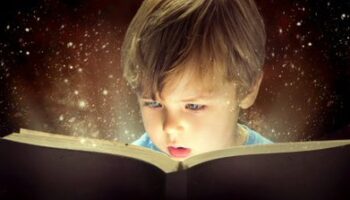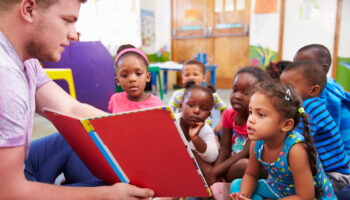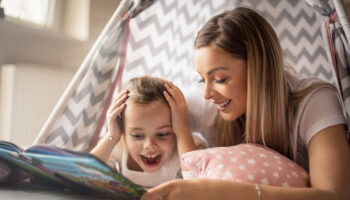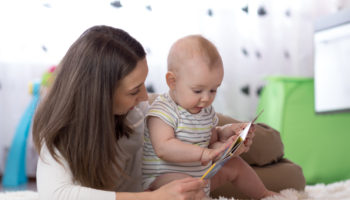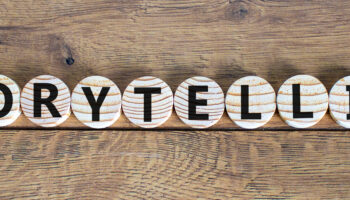Missy Littell, Customer Experience Manager, Cuyahoga Falls, OH, Library (formerly a children’s librarian for 12 years)
I will never forget the first time I read Eric Veillé’s My Pictures After the Storm to my children. Those laugh-out-loud moments, especially when shared with children, can be tough to beat. Just as play is recognized to be an important part of children’s learning experiences, so laughter and humor are an important part of a child’s reading and social experiences. “Laughter is an adaptive behavior that allows humans to counteract stress, become more tolerant and sympathetic of others, and live a more enjoyable life.” (Serafini & Coles, 2015.)
Also, it’s just plain fun to have a reason to laugh together!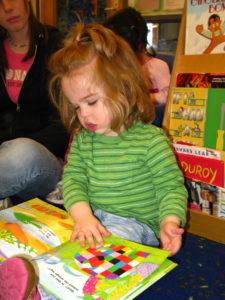
Below are a few of my tried and true favorite funny books, as well as favorites of friends, story time families and librarians across several states and library systems, categorized into my own just-for-fun groupings:
Potty Humor
Parents and teachers can sometimes be tempted to shy away from this topic for one simple reason: it’s not nearly as funny to adults (of course, there’s always that one guy…) as it is to children. If you don’t believe me, go read the Goodreads reviews on the book I Like Lemonade by Mark Sommerset. They’re all over the place. People loved and hated this book, which was the pinnacle of potty humor. Books like Walter the Farting Dog by William Botzwinkle are delightful to the Pre-K and elementary age crowd. With the recent release of the Captain Underpants movie, these books, always a favorite among the grades 1-6 group, are now flying off the shelves. While the idea of reading Captain Underpants and the Perilous Plot of Professor Poopypants isn’t my idea of a good time, my children would beg to differ.
Naked Humor
Not far from Potty Humor is Naked Humor. Kids will get it. Naked! by Michael Ian Black is worth the read just for the expressions on everyone’s faces as an energetic little boy goes flying around the house in the nude, wreaking havoc along the way. (If you’re worried about seeing parts, rest assured, there aren’t any to be seen in this book.) My personal favorite, though, is Naked Mole Rat Gets Dressed by Mo Willems. It combines the hilarious naked factor with a message about embracing differences when one of the moles tries to set up a shop selling clothes and is laughed out of town until the oldest and wisest, not to mention the most naked, mole rat decides that wearing clothes is a great idea. And suddenly Wilbur is a genius instead of a joke.
Dark(ish) Humor
This isn’t everyone’s favorite humor genre either, and it’s not for the faint of heart. I recently spent bedtimes reading Shel Silverstein’s Where the Sidewalk Ends to my sons, who are 6 and 9. I was struck by how hyperbolically dark some of these poems were. Think Hungry Mungry (about a child who eats the world, then himself), The Loser (about a boy who literally loses his head because he was so absent-minded) and Someone Ate the Baby (spoiler alert: it was the narrator of the poem). These were among my children’s favorites, the ones we had to read over and over again. Also be sure to check out Creepy Carrots by Aaron Reynolds and Creepy Pair of Underwear, which will be released on August 15, 2017. The shock value of Tadpole’s Promise by Jeanne Willis is what put this book on the map. I Want My Hat Back!/This is Not My Hat/We Found a Hat by Jon Klassen are other titles to explore if you find you enjoy the flavor of the twisted picture books.
Surprising Twists
This is a genre that is delightful to just about everyone. A funny surprise, at least in a book, is always a welcome treat. Francoise Mouly, in defense of funny comic books, states that “For readers, the process of concurrently interpreting text and images, of noting visual crescendos and subtle details, fosters curiosity, attentiveness, and imagination.” This can be seen not only in comic books, but also in series such as Mo Willem’s Pigeon or Elephant and Piggie books. (Check out my family’s favorite: We Are in a Book.) The characters’ priceless expressions as they interact with each other and the audience is half the fun, sometimes the main punch line. Pigeon’s tantrum when we refuse to let him drive the bus is both relatable and hilarious to little ones.
For other books with a surprise element or a touch of ludicrous, check out The Monster at the End of This Book by Jon Stone, I’m Bored by Michael Ian Black, Interrupting Chicken by David Ezra Stein, This Book Just Ate My Dog by Richard Byrne and Stuck by Oliver Jeffers.
Just Plain Old Funny
Some books have or need no category. They are just delightfully hilarious and that’s that. This list could go on and on, but here are a few favorites: The Book With No Pictures by B.J. Novak, Triangle by Mac Barnett, Dragons Love Tacos by Adam Rubin, Giggle, Giggle, Quack by Doreen Cronin, If You Give a Mouse a Cookie by Laura Joffe Numeroff, Prudence Wants a Pet by Cathleen Daly, Lion Lessons by Jon Agee, The Stinky Cheese Man and Other Fairly Stupid Tales by Jon Scieszka.
When it comes to encouraging children to learn to love reading, what we are trying to accomplish is getting across the idea that the information found within books is meaningful and valuable. What we also need to be communicating is that this information is not only desirable, it can also be delightful. Children love to laugh, and connecting them to books that help them do just that can be the key to a child becoming a life-long reader, and, if we’re fortunate, a more well-rounded person with an excellent sense of humor.
Mouly, F. (2017). What’s So Funny About Comics?. Horn Book Magazine, 93(3), 16-21.
Serafini, F., & Coles, R. (2015). Humor in Children’s Picture Books. Reading Teacher, 68(8), 636-638.
